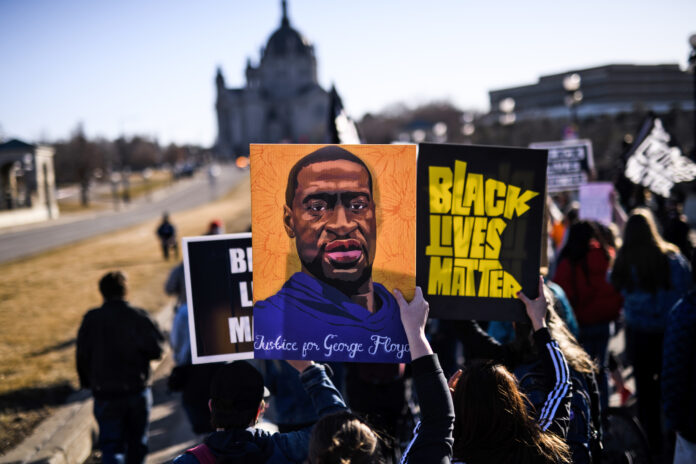Media coverage of the opioid epidemic has significant impacts on policy and public sympathy
Like 2 million Americans, George Floyd struggled with an opioid addiction. However, courtrooms and comment sections are devoid of sympathy for individuals like Floyd. Instead, his struggles with addiction have been put on trial.
The way Derek Chauvin’s defense transformed the final moments of Floyd’s death—where he lay breathless—to the fault of his addiction and not Chauvin’s knee pressed against Floyd’s neck for nine and a half minutes—shifts the blame to Floyd, offering no remorse for his wrongful death and no need for Chauvin to be held accountable for a life taken.
The defense’s utilization of Floyd’s drug addiction is a common practice used to demonize Black police brutality victims and remove a warrant of justice for their deaths at the hands of law enforcement. It is also symptomatic of the way drug addiction is framed not as a public health crisis but as a crime, especially in the way the opioid epidemic has been racialized and drawn in congruence with class division.
Opioids are used by over 100 million Americans suffering from chronic pain; such is the case for Floyd and his girlfriend Courtney Ross, who were prescribed opioids for chronic back and neck pain respectively. Between 2000 and 2012, the number of hospitalizations related to opioid misuse and dependency on prescription opioids has doubled. Because opioids are highly addictive, many individuals become dependent and after their prescription runs out, they are faced with painful withdrawal symptoms or they turn to other drugs, such as heroin, to “[get] their high.”
What differentiates the opioid epidemic from other drug crises—such as the crack epidemic that targeted poor Americans of color, is that “victims of opioid drug addiction were often portrayed by lawmakers and the media as ordinary white Americans who had fallen prey to a highly addictive substance.”
The centralization of the “ordinary white American” becoming the face of the opioid epidemic not only obscures public health disparities for Americans of color within it, but racializes drug addiction in congruence with class divisions to make determinants on whose drug addictions become regaled with sympathy, and others scorned. The inconsistency in portrayals of the opioid crisis has implications on policy response and public understanding of the crisis.
According to one study, there is a blatant difference in the way drug use is reported in Black and Latino urban communities versus suburban white ones.
These narratives run parallel to one another.
In the way drug use is reported in urban Black and Latino communities—according to the study—it is not deemed newsworthy because it is considered expected. As such, reports are clinical and straight to the point: criminal charges, names and the number of drugs. In its effect, the report dehumanizes the user to their drug use and offers no other narrative because it takes no interest in doing so. Meanwhile, drug use reported in suburban white communities centralizes on lost potential, where there is an investigative wonderment about individuals affected by drugs. Narratives are built against drug use which is whittled down to a tragedy; humanizing this form of drug use marks it an exception against the expectation of drug use.
The issue with the way the media diverges in covering narratives surrounding drug addiction is that it falls directly into our public consciousness and creates judgment calls when certain aspects of drug use are readily associated along color and class lines. While addiction transcends these lines, media coverage does not; and in turn, it reframes public empathy against individuals already facing heavy stigma when it comes to addiction.
The significance of these diverging forms of coverage also obscures underlying disparities in treatment. For example, Black Americans were 77% less likely to be prescribed buprenorphine, a drug that “limits the desire for opioids,” and are instead prescribed methadone which creates issues of accessibility as patients have to show up daily to medical offices to receive the drug.
For poor white individuals who use drugs, the class divide between doctor and patient is especially pronounced, according to a study. While in suburbia there is a familiarity between doctor and patient, in states like Vermont, medical professionals were reportedly “frustrated with their patients, viewing their poverty-related struggles such as lack of transportation or difficulty finding employment as ‘excuses’ for not succeeding in recovery.”
Framing Floyd’s cause of death as connected to his addiction raises the importance of a life struggling with drug addiction. As Chris McGreal for The Guardian argues, “if the defense claim is that Floyd was overdosing, or at least under the influence of drugs, why did Chauvin and his fellow officers […] not recognize that the man in their custody was in crisis?”
Drug addiction transcends race and class borders. Yet when we weigh these lives against one another—lives of expectation and exception—we create borders around addiction that put fault on one individual and invite consciousness for another, creating divergent policies and treatments for these individuals.
Written by: Renee Wang — reswang@ucdavis.edu Disclaimer: The views and opinions expressed by individual columnists belong to the columnists alone and do not necessarily indicate the views and opinions held by The California Aggie.




